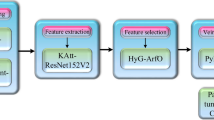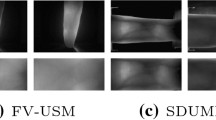Abstract
Finger-vein verification is a considerable problem to be addressed in a biometric system. A lot of research works have been intended for finger-vein authentication with aid of diverse data mining algorithms. But, the verification accuracy using conventional algorithms was minimal. Also, the time complexity involved during the finger-vein verification was maximal. To overcome the above drawbacks, Steepest Deep Bipolar Cascade Correlative Machine Learning (SDBCCML) technique is proposed. The proposed SDBCCML technique is designed to efficiently perform the finger-vein verification process when considering the large size of the dataset as input. The proposed SDBCCML technique contains three main components namely input, hidden, and output units for effective finger-vein authentication. The input unit in the proposed SDBCCML technique takes a number of finger vein images as input and then sent it to the hidden units. The proposed SDBCCML technique employs more numbers of hidden units with aiming to deeply learn the input finger vein images and thereby find the significant vein features by using the Gabor filter. Subsequently, the discovered vein features at hidden units are forwarded to the output unit. In the proposed SDBCCML technique, the output unit applies a bipolar activation function that compares the extracted vein features with pre-stored templates in the dataset. After that, the output unit gives the verification result. If the output unit result is +1, then the input finger vein image is classified as an authorized person. If the output unit result is −1, then the input finger vein image is classified as an unauthorized person. Thus, the main contribution of the proposed SDBCCML technique increases the authentication performance of finger-vein with higher accuracy and minimal time. The simulation of the proposed SDBCCML technique is conducted using metrics such as accuracy, time complexity, error rate, F-Score, and space complexity for a diverse number of finger-vein images.








Similar content being viewed by others
References
Qin H, El Yacoubi MA, Lin J, Liu B (2019) An iterative deep neural network for hand-vein verification. IEEE Access 7:34823–34837
Hou B, Yan R (2020) Convolutional auto-encoder model for finger-vein verification. IEEE Trans Instrum Meas 69:2067–2074
Qin H, El-Yacoubi MA (2017) Deep representation-based feature extraction and recovering for finger-vein verification. IEEE Trans Inf Forensics Secur 12(8):1816–1829
Yuxun F, Wu Q, Kang W (2018) A novel finger vein verification system based on two-stream convolutional network learning. Neurocomputing, Elsevier 290:100–107
Hu N, Ma H, Zhan T (2020) Finger vein biometric verification using block multi-scale uniform local binary pattern features and block two-directional two-dimension principal component analysis. Optik, Elsevier 208:1–19
Ma H, Zhang SY (2019) Contactless finger-vein verification based on oriented elements feature. Infrared Phys Technol, Elsevier 97:149–155
Qin H, He X, Yao X, Li H (2017) Finger-vein verification based on the curvature in radon space. Expert Syst Appl, Elsevier 82:151–161
Wu J-D, Liu C-T (2011) Finger-vein pattern identification using principal component analysis and the neural network technique. Expert Syst Appl, Elsevier 38(5):5423–5427
Matsuda Y, Miura N, Nagasaka A, Kiyomizu H, Miyatake T (2016) Finger-vein authentication based on deformation-tolerant feature-point matching. Mach Vis Appl, Springer 27:237–250
Banerjee A, Basu S, Basu S, Nasipuri M (2018) ARTeM: a new system for human authentication using finger vein images. Multimed Tools Appl, Springer 77:5857–5884
Song W, Kim T, Kim HC, Choi JH, Kong H-J, Lee S-R (2011) A finger-vein verification system using mean curvature. Pattern Recogn Lett, Elsevier 32(11):1541–1547
Tang S, Zhou S, Kang W, Wu Q, Deng F (2019) Finger vein verification using a Siamese CNN. IET Biometrics 8(5):306–315
Radzi SA, Khalil-Hani M, Bakhteri R (2016) Finger-vein biometric identification using convolutional neural network. Turk J Electr Eng Comput Sci 24:1863–1878
Wang R, Wang G, Chen Z, Zeng Z, Wang Y (2014) A palm vein identification system based on Gabor wavelet features. Neural Comput Applic 24:161–168
Meng X, Xi X, Yang G, Yin Y (2018) Finger vein recognition based on deformation information. SCIENCE CHINA Inf Sci, Springer 61:1–15
Lin C, Mingzhong L, Xiao S (2012) A finger vein recognition algorithm based on gradient correlation. AASRI Procedia, Elsevier 1:40–45
Qin H, Qin L, Xue L, He X, Yu C, Liang X (2013) Finger-vein verification based on multi-features fusion. Sensors 13:15048–15067
Ajay Kumar K, Prathyusha V (2009) Personal authentication using hand vein triangulation and knuckle shape. IEEE Trans Image Process 18(9):2127–2136
Yang W, Ma G, Li W, Liao Q (2013) Finger vein verification based on neighbor pattern coding. IEICE Trans Inf Syst E96-D(5):1227–1229
You W, Zhou W, Huang J, Yang F, Liu Y, Chen Z (2019) A bilayer image restoration for finger vein recognition. Neurocomputing, Elsevier 348:54–65
Syarif MA, Ong TS, Teoh ABJ, Tee C (2017) Enhanced maximum curvature descriptors for finger vein verification. Multimed Tools Appl, Springer 76(5):6859–6887
Fayyaz M, PourReza M, Saffar MH, Sabokrou M, Fathy M (2015) A novel approach for finger vein verification based on self-taught learning. Comput Vis Pattern Recognit 7:1–4
Wu J-D, Liu C-T (2011) Finger-vein pattern identification using SVM and neural network technique. Expert Syst Appl 38(11):14284–14289
Al-juboori AM, Bu W, Wu X, Zhao Q (2014) Palm vein verification using multiple features and locality preserving projections”, Hindawi Publishing Corporation. Sci World J 2014:1–11
Liu BC, Xie SJ, Park DS (2016) Finger Vein Recognition Using Optimal Partitioning Uniform Rotation Invariant LBP Descriptor. J Electr Comput Eng 2016:1–10
Kumar A, Zhou Y (2012) Human identification using finger images. IEEE Trans Image Process 21(4):2228–2244
Qin H, Qin L, Yu C (2011) Region growth-based feature extraction method for finger-vein recognition. Opt Eng 50(5):1–9
Liu F, Yang G, Yin Y, Wang S (2014) Singular value decomposition based minutiae matching method for finger vein recognition. Neurocomputing 145:75–89
Liu H, Lu Y, Yang G, Yin Y (2017) Discriminative binary descriptor for finger vein recognition. IEEE Access 6:5795–5804
Liu T, Xie J, Yan W, Li P, Lu H (2015) Finger-vein recognition with modified binary tree model. Neural Comput & Applic, Springer 26:969–977
Amalraj R, Dharmalingam M (2015) A work point system coupled with Back-propagation for solving double dummy bridge problem. Neurocomputing, Elsevier 168:160–178
Dharmalingam M, Amalraj R (2014) A solution to the double dummy bridge problem in contract bridge influenced by supervised learning module adapted by artificial neural network. ICTACT Journal on Soft Computing: Special Issue on Distributed Intelligent System and Applications 05:836–843
Dharmalingam M, Amalraj R (2014) Fast supervised learning architecture - a work point count system coupled with resilient Back-propagation algorithm for solving the double dummy bridge problem. Int J Emerg Trends Technol Comput Sci 03:189–195
Dharmalingam M (2018) Double dummy bridge problem in contract bridge: an overview. Int J Artif Intell Syst Mach Learn 10:01–07
Dharmalingam M (2018) Imperfect information game of contract bridge using double dummy bridge problem in Elman neural network architecture. Int J Modern Electron Commun Eng 06:94–101
Praveenkumar GD, Dharmalingam M (2019) Pruned Cascade neural network image classification. Int J Recent Technol Eng 8:6454–6457
Praveenkumar GD, Dharmalingam M (2019) Recurrent Cascade neural network for image classification. Int J Sci Technol Res 8:1009–1012
Rakkimuthu P, Dharmalingam M (2019) A review on image enhancement on finger-vein biometrics. JETIR 6:86–90
Rakkimuthu P, Dharmalingam M (2019) Convolutions neural network for finger vein verification, International Conference Proceeding, ICCIA, ISBN-9789386712844: 35–39
Rakkimuthu P, Dharmalingam M (2019) Delta ruled fully recurrent deep learning for finger-vein verification. IJITEE 9:1580–1588
Barman B, Patra S (2020) Variable precision rough set based unsupervised band selection technique for hyperspectral image classification. Knowl-Based Syst 193:1–10
Jun O, Li Y, Liu W (2020) TDP: two-dimensional perceptron for image recognition. Knowl-Based Syst 195:1–6
Zeng J, Wang F, Deng J, Qin C, Zhai Y, Gan J, Vincenzo PI (2020) Finger vein verification algorithm based on fully convolutional neural network and conditional random field. IEEE Access 8:65402–65419
Liu H, Yang G, Lu Y, Kun S, Yin Y (2019) Anchor-based manifold binary pattern for finger vein recognition. SCIENCE CHINA Inf Sci , Springer 62:1–16
Alay N, Al-Baity HH (2020, MDPI) Deep Learning Approach for Multimodal Biometric Recognition System Based on Fusion of Iris, Face, and Finger Vein Traits. Sensors 20:1–17
Bahmed F, Mammar MO, Ouamri A (2019) A multimodal hand recognition system based on finger inner-knuckle print and finger geometry. J Appl Secur Res, Routledge Taylor & Francis Group 14:48–73
Jin J, Di S, Li W, Sun X, Wang X (2021) Finger vein recognition algorithm under reduced field of view. IET Image Process, Wiley 15:947–955
Kuzu RS, Piciucco E, Maiorana E, Campisi P (2020) On-the-Fly Finger-Vein-Based Biometric Recognition Using Deep Neural Networks. IEEE Trans Inf Forensics Secur 15:2641–2654
Boucherit I, Zmirli MO, Hentabli H, Rosdi BA (2020) Finger vein identification using deeply-fused convolutional neural network. Journal of King Saud University - Computer and Information Sciences, Elsevier:1–11. https://doi.org/10.1016/j.jksuci.2020.04.002
Kumar N, Sukavanam N (2020) A cascaded CNN model for multiple human tracking and re-localization in complex video sequences with large displacement. Multimed Tools Appl, Springer 79:6109–6134
Yin Y, Liu L, Sun X (2011) SDUMLA-HMT: A multimodal biometric database. In: Sun Z, Lai J, Chen X, Tan T (eds) Biometric Recognition. CCBR 2011. Lecture Notes in Computer Science, vol 7098. Springer, Berlin, Heidelberg. https://doi.org/10.1007/978-3-642-25449-9_33
Zhang J, Chen M, Sun H, Li D, Wang Z (2020) Object semantics sentiment correlation analysis enhanced image sentiment classification. Knowl-Based Syst 191:1–30
Author information
Authors and Affiliations
Corresponding author
Ethics declarations
Conflict of interest
The authors declare that they have no conflict of interest.
Additional information
Publisher’s note
Springer Nature remains neutral with regard to jurisdictional claims in published maps and institutional affiliations.
Rights and permissions
About this article
Cite this article
Muthusamy, D., Rakkimuthu, P. Steepest deep bipolar Cascade correlation for finger-vein verification. Appl Intell 52, 3825–3845 (2022). https://doi.org/10.1007/s10489-021-02619-5
Accepted:
Published:
Issue Date:
DOI: https://doi.org/10.1007/s10489-021-02619-5




